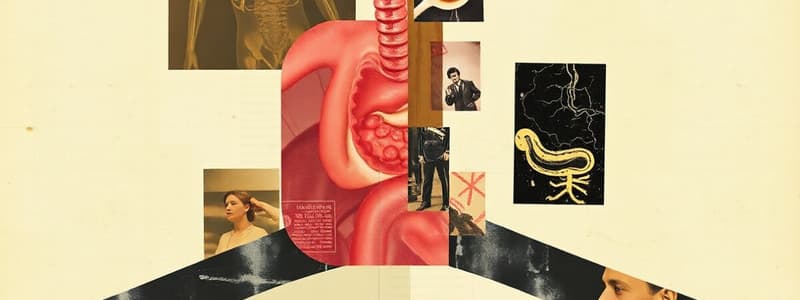Podcast
Questions and Answers
Chronic gastritis is a major factor in the development of peptic ulcer disease (PUD).
Chronic gastritis is a major factor in the development of peptic ulcer disease (PUD).
True (A)
Helicobacter pylori infection is not considered a risk factor for PUD.
Helicobacter pylori infection is not considered a risk factor for PUD.
False (B)
The macroscopic features of PUD include lesions that may vary in size from millimeters to centimeters.
The macroscopic features of PUD include lesions that may vary in size from millimeters to centimeters.
True (A)
The base of a peptic ulcer is generally rough and irregular due to peptic digestion.
The base of a peptic ulcer is generally rough and irregular due to peptic digestion.
Malignant transformation of peptic ulcers is a common complication.
Malignant transformation of peptic ulcers is a common complication.
Barrett oesophagus is characterized by intestinal metaplasia of the gastric mucosa.
Barrett oesophagus is characterized by intestinal metaplasia of the gastric mucosa.
Acute gastritis is typically a chronic condition that results in significant long-term inflammation of the gastric mucosa.
Acute gastritis is typically a chronic condition that results in significant long-term inflammation of the gastric mucosa.
Regurgitation and heartburn are common symptoms of gastroesophageal reflux disease (GERD).
Regurgitation and heartburn are common symptoms of gastroesophageal reflux disease (GERD).
Chronic gastritis involves a neutrophilic infiltrate as its primary immune response.
Chronic gastritis involves a neutrophilic infiltrate as its primary immune response.
Hiatus hernia is not considered a contributing factor to GERD.
Hiatus hernia is not considered a contributing factor to GERD.
Chronic gastritis is characterized by acute mucosal inflammatory changes.
Chronic gastritis is characterized by acute mucosal inflammatory changes.
Mucosal erosion in acute gastritis signifies the loss of superficial epithelium and can lead to hemorrhage.
Mucosal erosion in acute gastritis signifies the loss of superficial epithelium and can lead to hemorrhage.
Helicobacter pylori is the most common cause of chronic gastritis, accounting for 90% of cases.
Helicobacter pylori is the most common cause of chronic gastritis, accounting for 90% of cases.
Increased gastric volume is a factor that can lead to gastroesophageal reflux disease.
Increased gastric volume is a factor that can lead to gastroesophageal reflux disease.
Chronic infection by Helicobacter pylori is primarily transmitted through contaminated water.
Chronic infection by Helicobacter pylori is primarily transmitted through contaminated water.
Stress is considered a major cause of chronic gastritis.
Stress is considered a major cause of chronic gastritis.
Autoimmune gastritis accounts for more than 10% of cases of chronic gastritis.
Autoimmune gastritis accounts for more than 10% of cases of chronic gastritis.
Peptic ulcer disease is primarily characterized by chronic mucosal ulceration affecting the esophagus.
Peptic ulcer disease is primarily characterized by chronic mucosal ulceration affecting the esophagus.
Toxins like alcohol and smoking are not associated with chronic gastritis.
Toxins like alcohol and smoking are not associated with chronic gastritis.
The colonization rate of Helicobacter pylori increases with age.
The colonization rate of Helicobacter pylori increases with age.
Inflammation in chronic gastritis can involve neutrophils and plasma cells.
Inflammation in chronic gastritis can involve neutrophils and plasma cells.
Peptic ulcers are considered curable with the right treatment.
Peptic ulcers are considered curable with the right treatment.
Patients with Helicobacter pylori associated chronic gastritis typically present with decreased acid production.
Patients with Helicobacter pylori associated chronic gastritis typically present with decreased acid production.
Eosinophilic gastritis is a common type of gastritis.
Eosinophilic gastritis is a common type of gastritis.
Bacterial virulence factors of Helicobacter pylori include its flagella and urease.
Bacterial virulence factors of Helicobacter pylori include its flagella and urease.
Mechanical injury to the gastric mucosa is a recognized cause of chronic gastritis.
Mechanical injury to the gastric mucosa is a recognized cause of chronic gastritis.
The presence of H.pylori is almost always associated with peptic ulcer disease.
The presence of H.pylori is almost always associated with peptic ulcer disease.
Vitamin B12 deficiency can occur due to autoimmune gastritis.
Vitamin B12 deficiency can occur due to autoimmune gastritis.
The loss of parietal cells and chief cells in autoimmune gastritis is often minimal.
The loss of parietal cells and chief cells in autoimmune gastritis is often minimal.
Flashcards
Gastroesophageal Reflux Disease (GERD)
Gastroesophageal Reflux Disease (GERD)
A condition where stomach acid flows back into the esophagus, causing irritation and inflammation.
Barrett's Esophagus
Barrett's Esophagus
A complication of chronic GERD, involving changes in the esophageal lining.
Lower Esophageal Sphincter Relaxation
Lower Esophageal Sphincter Relaxation
A key factor in GERD, where the muscle at the bottom of the esophagus relaxes inappropriately, allowing acid reflux.
Gastritis
Gastritis
Signup and view all the flashcards
Acute Gastritis
Acute Gastritis
Signup and view all the flashcards
Chronic Gastritis
Chronic Gastritis
Signup and view all the flashcards
Peptic Ulcer Disease (PUD)
Peptic Ulcer Disease (PUD)
Signup and view all the flashcards
Causes of Acute Gastritis
Causes of Acute Gastritis
Signup and view all the flashcards
Symptoms of GERD
Symptoms of GERD
Signup and view all the flashcards
Complication of GERD
Complication of GERD
Signup and view all the flashcards
Chronic Gastritis
Chronic Gastritis
Signup and view all the flashcards
Helicobacter pylori
Helicobacter pylori
Signup and view all the flashcards
H. pylori transmission
H. pylori transmission
Signup and view all the flashcards
H. pylori virulence factors
H. pylori virulence factors
Signup and view all the flashcards
Gastric Mucosal Defense Mechanisms
Gastric Mucosal Defense Mechanisms
Signup and view all the flashcards
H. pylori pathogenesis
H. pylori pathogenesis
Signup and view all the flashcards
Chronic Gastritis location
Chronic Gastritis location
Signup and view all the flashcards
Etiology of Chronic Gastritis
Etiology of Chronic Gastritis
Signup and view all the flashcards
PUD development
PUD development
Signup and view all the flashcards
H. pylori
H. pylori
Signup and view all the flashcards
Risk factors PUD
Risk factors PUD
Signup and view all the flashcards
PUD lesion site
PUD lesion site
Signup and view all the flashcards
PUD lesion appearance
PUD lesion appearance
Signup and view all the flashcards
PUD macroscopic features
PUD macroscopic features
Signup and view all the flashcards
PUD microscopic zones
PUD microscopic zones
Signup and view all the flashcards
PUD complications
PUD complications
Signup and view all the flashcards
Chronic Gastritis
Chronic Gastritis
Signup and view all the flashcards
H. pylori
H. pylori
Signup and view all the flashcards
Autoimmune Gastritis
Autoimmune Gastritis
Signup and view all the flashcards
Parietal Cells
Parietal Cells
Signup and view all the flashcards
Vitamin B12 Deficiency
Vitamin B12 Deficiency
Signup and view all the flashcards
Peptic Ulcer
Peptic Ulcer
Signup and view all the flashcards
Peptic Ulcer Disease
Peptic Ulcer Disease
Signup and view all the flashcards
Gastric Adenocarcinoma
Gastric Adenocarcinoma
Signup and view all the flashcards
MALT Lymphoma
MALT Lymphoma
Signup and view all the flashcards
Mucosal Atrophy
Mucosal Atrophy
Signup and view all the flashcards
Intestinal Metaplasia
Intestinal Metaplasia
Signup and view all the flashcards
Study Notes
Reflux Esophagitis, Gastritis & Peptic Ulcer Disease
- Reflux disease is a common issue in the gastrointestinal tract
- Stomach acid and pepsin reflux into the lower esophagus
- This causes irritation, inflammation, and damage to the lower esophageal mucosa
- Can progress to intestinal metaplasia (Barrett's esophagus)
Barrett's Esophagus
- Chronic GERD complication
- Characterized by intestinal metaplasia of esophageal squamous mucosa
- Endoscopy shows red, velvety mucosa extending upwards
Pathogenesis of GERD
- Multifactorial
- Transient lower esophageal sphincter relaxation is a major cause
- Increased intra-abdominal pressure (e.g., pregnancy, old age, alcohol, tobacco)
- Hiatus hernia
- Delayed gastric emptying
- Defective esophageal mucosal resistance
- Increased gastric volume
- CNS depressants
Gastritis
- Inflammation of the gastric mucosa
- Can be acute (neutrophils) or chronic (lymphocytes and plasma cells) or mixed
- Acute gastritis is usually transient
- Severe erosive form can cause gastrointestinal bleeding
- Causes include NSAIDs, chemotherapy, excessive alcohol and smoking, stress, ischemia, shock, severe systemic infections (like salmonellosis), uraemia, acids and alkalis, mechanical trauma (e.g., nasogastric intubation), post-distal gastrectomy
Morphology
- Mucosal edema
- Vascular congestion
- Neutrophil infiltrate in the epithelial cells (signifies inflammation)
- Severe form: mucosal erosion & hemorrhage
Histology
- Neutrophils within the epithelial cells
Chronic Gastritis
- Chronic mucosal inflammatory changes leading to mucosal atrophy and epithelial metaplasia
- Can be a background to carcinoma development
- Etiology includes chronic infection by Helicobacter pylori (the most common cause), autoimmune conditions, toxins (alcohol, smoking), radiation, and chronic bile reflux (after gastroenterostomy)
Helicobacter pylori Associated Chronic Gastritis
- Most common cause (90%) is H. pylori
- Curved, gram-negative rod, transmitted fecal-oral
- Associated with poverty and overcrowding
- Usually acquired in childhood
- Pathogenesis involves bacterial virulence factors (flagella, urease, adhesins) and host factors (genetic polymorphisms affecting proinflammatory/anti-inflammatory cytokine expression).
Morphology (H. pylori Associated Chronic Gastritis)
- Predominantly affects the antrum
- Patients may have normal or increased acid production
- Organisms concentrate in surface mucosa over epithelial cells
- Inflammation (neutrophils, plasma cells, lymphoid aggregates)
- Can progress to patchy mucosal atrophy and intestinal metaplasia, leading to complications such as peptic ulcers, gastric adenocarcinoma, and MALT lymphoma.
Autoimmune Gastritis
- Less than 10% of chronic gastritis cases
- Involves body and fundus, spares antrum and cardia
- Autoimmune destruction of parietal cells
- Characterized by:
- Antibodies to parietal cells and intrinsic factor
- Decreased acid production (achlorhydria) and increased gastrin release
- Vitamin B12 deficiency (pernicious anaemia)
- Reduced serum pepsinogen I
- Often associated with other autoimmune diseases
Peptic Ulcer Disease
- Chronic mucosal ulceration in the duodenum or stomach
- Usually associated with H. pylori, NSAIDs or cigarette smoking
- Peptic ulcers are relapsing lesions, most commonly diagnosed in middle-aged to older adults
- Pathogenesis: imbalance between gastroduodenal mucosal defense mechanisms and damaging factors. PUD often develops on a background of chronic gastritis
Pathogenesis of Peptic Ulcer
- Aggressive forces (e.g., H. pylori, NSAIDs, aspirin, corticosteroids, smoking, alcohol)
- Imbalance between aggressive forces and mucosal defense mechanisms (e.g., surface mucus secretion, bicarbonate secretion, mucosal blood flow, epithelial regeneration, and prostaglandin elaboration)
Macroscopic Features (Peptic Ulcers)
- Usually solitary
- Sites include the first part of the duodenum, lesser curvature of the stomach, and the antrum
- Shallow or deep, various sizes (mm to cm)
- Round to oval lesions, relatively straight walls.
- Mucosal margin may overhang the base, which is clean
- Later, there is scarring and puckering of the surrounding tissue with folds radiating from the crater
Chronic Gastric Ulcer (Microscopy)
- Four zones:
- Superficial necrotic debris and fibrin
- Inflammatory cells (predominantly neutrophils) beneath the superficial layer
- Granulation tissue in deeper layers
- Collagenous/fibrous scar with thick-walled thrombosed vessels
Complications
- Chronic Gastric Ulcer and Peptic Ulcer:
- Bleeding
- Perforation
- Obstruction (due to edema or scarring)
- Malignant transformation (very rare)
Studying That Suits You
Use AI to generate personalized quizzes and flashcards to suit your learning preferences.




